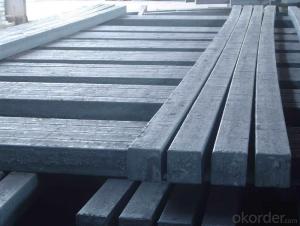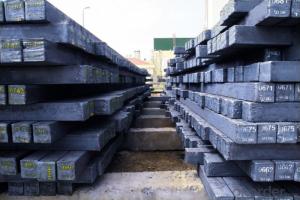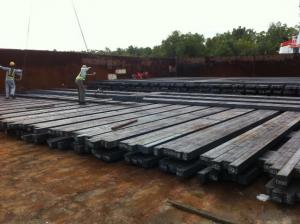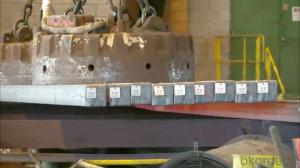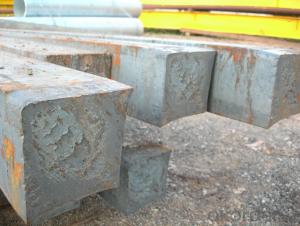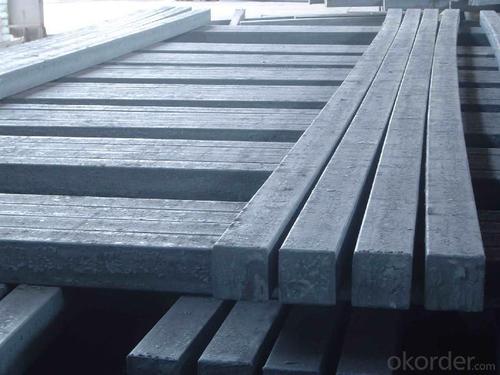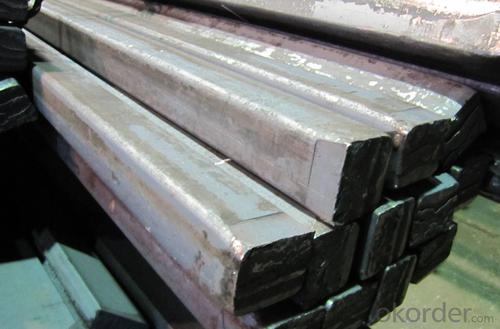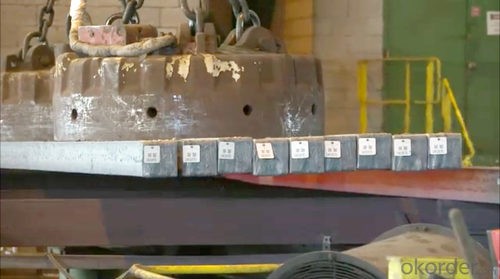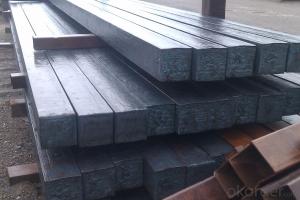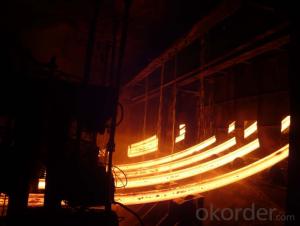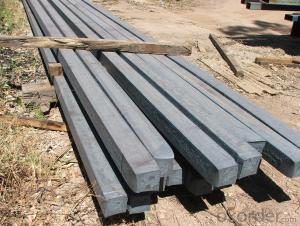Hot Rolled Square Steel Billet 3SP Standard 155mm
- Loading Port:
- Shanghai
- Payment Terms:
- TT OR LC
- Min Order Qty:
- 2000 m.t.
- Supply Capability:
- 10000 m.t./month
OKorder Service Pledge
OKorder Financial Service
You Might Also Like
Structure of Hot Rolled Square Steel Billet 3SP Standard 155mm
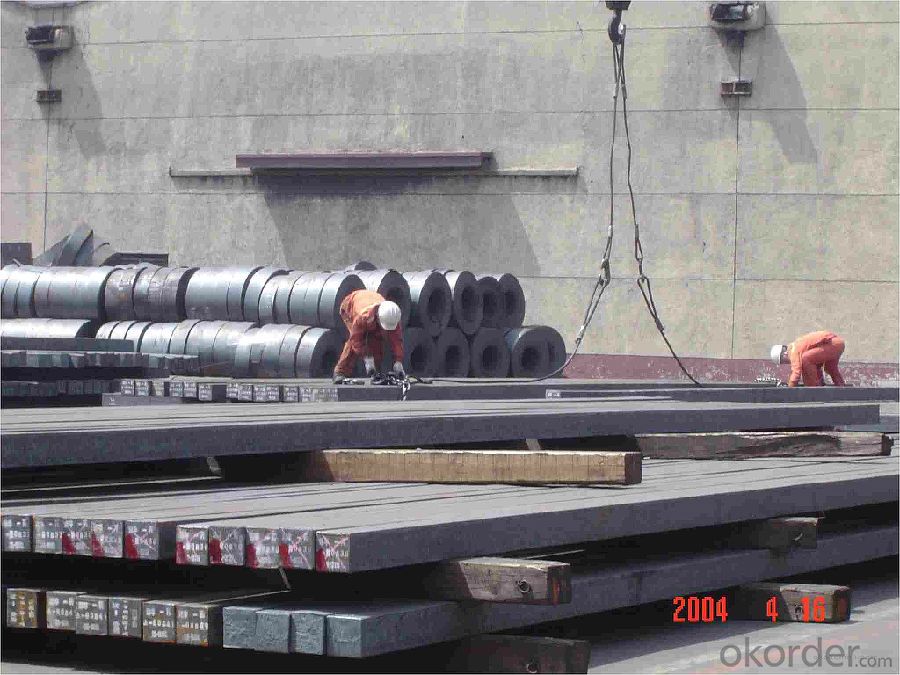
Description of Hot Rolled Square Steel Billet 3SP Standard 155mm
PPGI is made by cold rolled steel sheet and galvanized steel sheets as baseplate, through the surface pretreatment (degreasing, cleaning, chemical conversion processing), coated by the method of continuous coatings (roller coating method),
and after roasting and cooling. Zinc coating: Z60, Z80, Z100, Z120, Z180, Z275, G30, G60, G90
Alu-zinc coating: AZ60, AZ80, AZ100, AZ120, AZ180, G30, G60, G90
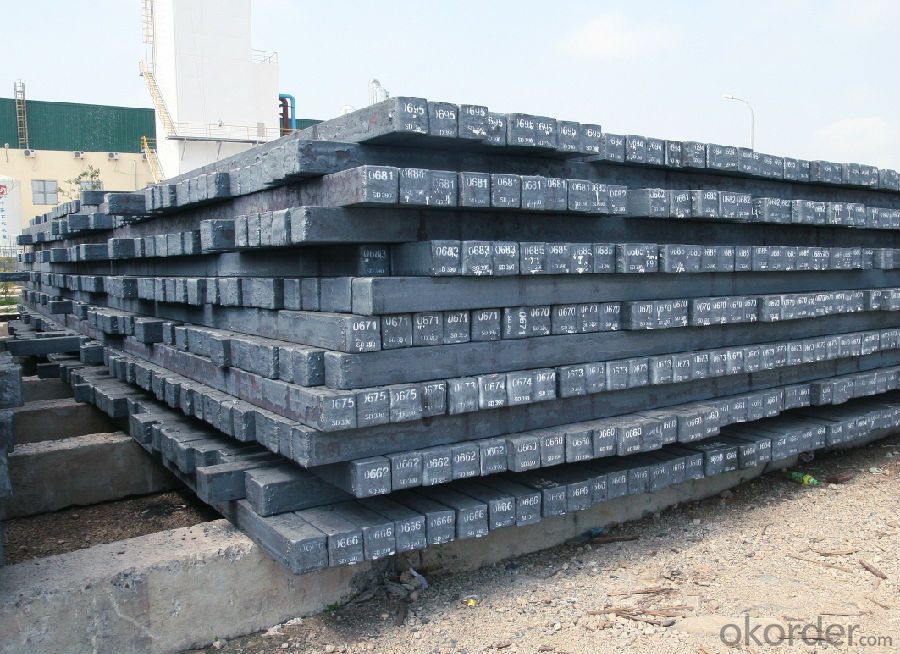
Main Feature of Hot Rolled Square Steel Billet 3SP Standard 155mm
1) Excellent corrosion resistance: The zinc layer provides a good protection of Pre-painted Galvanizeed Steel Sheet.
2) High heat resistance: The reflective surface of the material aids in efficiently reflecting the sunlight away and in turn reducing the amount of heat transmitted. The thermal reflectivity converts into energy savings.
3) Aesthetics: Pre-Painted Galvanized steel sheet is available in plethora of patterns and multiple sizes as per the requirements that given by our customers.
4) Versatility: can be used in the various areas.Standard seaworthy export packing: 3 layers of packing, inside is kraft paper, water plastic film is in the middle and outside GI steel sheet to be covered by steel strips with lock, with inner coil sleeve.
Applications of Hot Rolled Square Steel Billet 3SP Standard 155mm
1) Automotive bodies: filters, fuel tanks, etc.
2) Construction materials: roofings, welding pipes,
3) Electric and electronic appliances: computer cans, etc.
4) Steel cans: containers, etc.
5) Steel furniture: washing machines, refrigerators, microwaves, etc.
6) Drums
7) Office equipment: printer, recorders, etc.
8) Motors and transformers
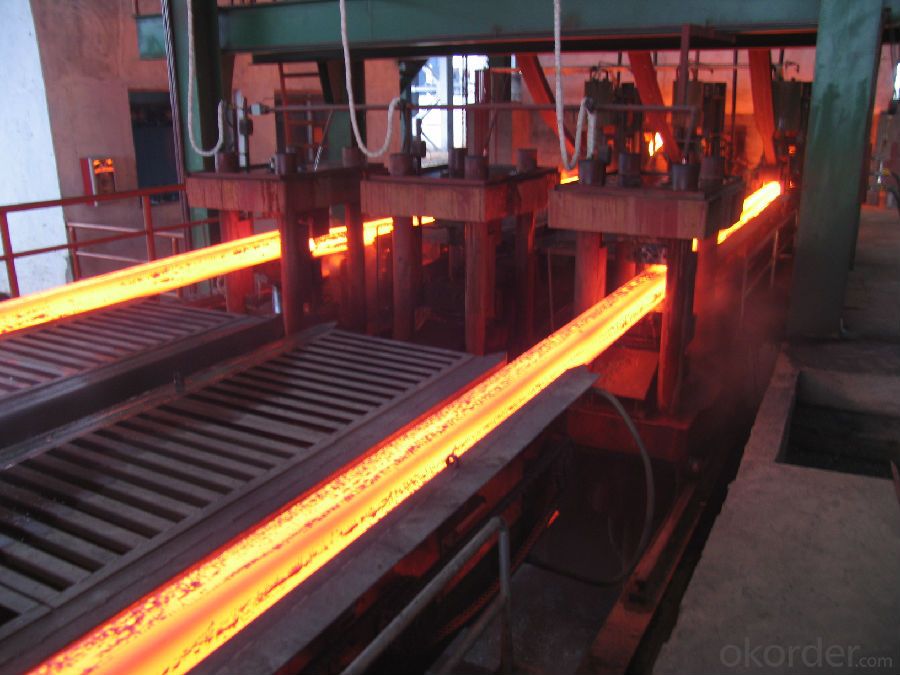
Specifications of Hot Rolled Square Steel Billet 3SP Standard 155mm
| Classified symbol | Yield Point Minimum N/mm2 | Tensile Strength Minimum | Elongation Minimum % | Application | ||||
| N/mm2 | Nominal Thickness mm (t) | |||||||
| JIS | Yogic | 0.25-0.4 | 0.4-0.6 | 0.6-1.0 | 1.0-1.6 | |||
| G3312 | specification | |||||||
| CGCC | CGCC | -205 | -270 | -20 | -21 | -24 | -24 | Commercial |
| CGCD | CGCD | --- | 270 | --- | 27 | 31 | 32 | Drawing |
| --- | CG340 | 245 | 340 | 20 | 20 | 20 | 20 | Structural |
| CGC400 | CG400 | 295 | 400 | 16 | 17 | 18 | 18 | Structural |
| CGC440 | CG440 | 335 | 440 | 14 | 15 | 16 | 18 | Structural |
| CGC490 | CG490 | 365 | 490 | 12 | 13 | 14 | 16 | Structural |
| CGC570 | CG570 | 560 | 570 | --- | --- | --- | --- | Structural |
| ASTM Designation | Yield Point Minimum | Tensile Strength Minimum | Elongation Minimum % | Application | Q/BQB 445-2004(China standard) | ASM A653/A653M | JISG 3312 | |
| ksi(MPa) | ksi(MPa) | TDC51D+Z | (CS TYPE A+Z) | CGCC | ||||
| A653(M)-99 CS TYPE A,B,C | --- | --- | --- | Commercial | TDC52D+Z | CGCD | ||
| A653(M)-99 FS | --- | --- | --- | Lock Forming | TS250GD+Z | (G250+Z) | - | |
| A653(M)-99 DS | --- | --- | --- | Drawing | TS300GS+Z | (G300+Z) | CGC 400 | |
| A653(M)-99 SS Grade33(230) | 33(230) | 45(310) | 20 | Structural | TS350GD+Z | (G350+Z) | CGC490 | |
| A653(M)-99 SS Grade37(255) | 37(255) | 52(360) | 18 | Structural | TS550GD+Z | (G550+Z) | CGC570 | |
| A653(M)-99 SS Grade40(275) | 40(275) | 55(380) | 16 | Structural | ||||
| A653(M)-99 SS Grade50(345) | 50(345) | 65(450) | 12 | Structural | ||||
| A653(M)-99 SS Grade80(550) | 80(550) | 82(570) | --- | Structural | ||||
FAQ of Hot Rolled Square Steel Billet 3SP Standard 155mm
We have organized several common questions for our clients,may help you sincerely:
1. How Can I Visit There?
Our company is located in Tianjin City, China, near Beijing. You can fly to Tianjin Airport Directly. All our clients, from home or aboard, are warmly welcome to visit us!
2. How Can I Get Some Sample?
We are honored to offer you sample.
3. Why choose CNBM?
1, ISO, BV, CE, SGS approved.
2, Competitive price and quality.
3, Efficient service team online for 24 hours.
4, Smooth production ability(50000tons/month) .
5, quick delivery and standard exporting package.
6, Flexible payment with T/T, L/C, Paypal, Kunlun bank, etc.
- Q: What is the role of steel billets in the manufacturing of conveyor systems?
- The manufacturing of conveyor systems heavily relies on steel billets, which serve as the primary material for producing various components and parts. To begin with, steel billets play a vital role in constructing the framework and structure of the conveyor system. They are shaped and cut to form the main frame, supports, and other structural elements that provide stability and strength to the entire system. The superior strength and durability of steel make it an ideal material for this purpose, ensuring that the conveyor system can withstand heavy loads and operate efficiently. Moreover, steel billets are crucial in the fabrication of rollers and pulleys, which are indispensable components of conveyor systems. These rollers and pulleys are responsible for guiding and moving the conveyor belt, facilitating the smooth and uninterrupted flow of materials. Steel billets are forged and machined to create these components, guaranteeing their reliability and long lifespan even in demanding working conditions. Additionally, steel billets are also utilized in the production of brackets, connectors, and fasteners that secure the different parts of the conveyor system together. These components provide the necessary connections and attachments, ensuring the proper assembly and functioning of the conveyor system. Furthermore, steel billets offer the advantage of being moldable and shapeable into customized parts according to the specific requirements of the conveyor system. This flexibility allows conveyor manufacturers to design and manufacture conveyor systems that are tailored to the unique needs of various industries and applications. In conclusion, steel billets are essential in the manufacturing of conveyor systems as they provide the raw material for constructing the system's framework, rollers, pulleys, brackets, connectors, and other components. The high strength, durability, and flexibility of steel billets make them a vital ingredient in creating reliable and efficient conveyor systems.
- Q: What is the role of steel billets in the manufacturing of construction excavators?
- Steel billets play a crucial role in the manufacturing of construction excavators as they serve as the raw material for various components of the excavator. These billets are used to forge and shape the structural elements, such as the boom, arm, and bucket, which require high strength and durability to withstand the heavy-duty operations of an excavator. Additionally, steel billets are also used to fabricate the undercarriage and other critical parts, ensuring the overall stability and performance of the construction excavator.
- Q: What are the different methods of hardness testing for steel billets?
- There are several methods of hardness testing for steel billets, each offering different advantages and levels of accuracy. Some of the most common methods include: 1. Rockwell hardness testing: This is one of the most widely used methods and measures the depth of indentation caused by a specific load on a steel billet's surface. It provides a hardness value based on the depth of penetration, making it convenient and relatively quick to perform. 2. Brinell hardness testing: This method involves indenting a steel billet's surface with a spherical indenter under a specific load. The diameter of the resulting impression is measured to determine the hardness value. Brinell testing is especially useful for large billets or materials with a coarse microstructure. 3. Vickers hardness testing: Vickers testing uses a pyramidal diamond indenter to create an impression on the surface of a steel billet. The diagonal length of the impression is measured, and the hardness value is calculated based on the applied load. Vickers testing is suitable for a wide range of materials, including steel billets. 4. Knoop hardness testing: Similar to Vickers testing, Knoop hardness testing also uses a pyramidal diamond indenter. However, the indentation shape is elongated and narrower, allowing for measurements on smaller or thinner samples. This method is often used for precise and microhardness testing. 5. Leeb hardness testing: Leeb testing is a portable and non-destructive method that uses an impact device to measure the rebound hardness of a steel billet. The device strikes the surface with a small ball and measures the velocity of the rebound, which is then converted into a hardness value. This method is commonly used for on-site or in-field measurements. 6. Ultrasonic hardness testing: This method uses ultrasonic waves to measure the hardness of a steel billet. The waves are transmitted through the material, and the time taken for the waves to travel through the billet is measured. This data is then converted into a hardness value. Ultrasonic testing is non-destructive and suitable for large or thick billets. It is important to note that each hardness testing method has its own limitations and considerations. The choice of method will depend on factors such as the size, shape, and surface condition of the steel billet, as well as the desired accuracy and convenience of the testing process.
- Q: What are the different types of cleaning equipment used for steel billets?
- Steel billets commonly undergo cleaning using various types of equipment. These include: 1. Shot blasting machines: These machines propel small metal or mineral particles at high speed onto the surface of the billets, effectively eliminating rust, scale, and other contaminants, resulting in a clean and smooth surface. 2. Ultrasonic cleaners: Through the use of high-frequency sound waves, ultrasonic cleaning agitates a cleaning solution, effectively removing dirt, oil, and other contaminants from the billets' surface. This method is particularly useful for stubborn or hard-to-reach contaminants. 3. Acid pickling tanks: By immersing the billets in an acidic solution, acid pickling dissolves rust, scale, and other contaminants. After pickling, rinsing and drying are usually carried out. 4. Power washers: Power washers, also known as pressure washers, employ a high-pressure water spray to eliminate dirt, oil, and other contaminants from the billets' surface. This method is particularly effective for larger or heavier billets. 5. Mechanical cleaning brushes: Mechanical cleaning brushes, including wire brushes or abrasive pads, are commonly employed to manually scrub the billets' surface, removing loose dirt, rust, or scale. Typically used in conjunction with other cleaning methods. In determining the appropriate cleaning equipment for steel billets, factors such as the extent and type of contaminants, desired level of cleanliness, and the size and shape of the billets need to be considered. Different combinations of these cleaning methods may be utilized to achieve the desired outcome.
- Q: What are the main factors affecting the machinability of alloy steel billets?
- Several key factors influence the machinability of alloy steel billets. Firstly, the machinability can be affected by the alloy composition of the steel. Different alloying elements, including chromium, nickel, molybdenum, and vanadium, have varying impacts on the machinability. Chromium and molybdenum, which form hard carbides, tend to decrease machinability, while nickel and vanadium, which promote the formation of softer carbides, can enhance machinability. Secondly, the heat treatment of the alloy steel billets significantly impacts machinability. Processes such as annealing, normalizing, or quenching and tempering can alter the microstructure and hardness of the steel. Proper heat treatment can improve machinability by reducing hardness and increasing toughness, while improper heat treatment can result in increased hardness and decreased machinability. Thirdly, the presence of impurities and inclusions in the alloy steel billets can affect machinability. Inclusions, such as sulfides, oxides, and non-metallic particles, can cause tool wear and chip breakability issues during machining. Therefore, the cleanliness and purity of the alloy steel billets are crucial factors in determining machinability. Furthermore, the mechanical properties of the alloy steel, such as hardness, strength, and ductility, can influence machinability. Higher hardness and strength levels can make machining more challenging, while increased ductility and toughness can improve machinability. Lastly, the cutting conditions and machining parameters, including cutting speed, feed rate, depth of cut, and tool material, also impact machinability. Optimal cutting conditions should be selected based on the specific alloy steel composition and desired machinability. Adequate cooling and lubrication during machining are also essential to reduce friction and heat, preventing tool wear and improving machinability. In conclusion, the machinability of alloy steel billets is influenced by factors such as alloy composition, heat treatment, impurities and inclusions, mechanical properties, and cutting conditions. Proper consideration of these factors can help optimize the machinability of alloy steel and ensure efficient and effective machining processes.
- Q: How are steel billets used in the production of structural steel sections?
- Steel billets are a crucial component in the production of structural steel sections. These billets serve as the primary raw material for the manufacturing process. To begin with, steel billets are melted in a furnace to create molten steel. This molten steel is then cast into billets of specific sizes and shapes, which can vary depending on the desired structural steel section to be produced. The billets are typically rectangular or square in shape. Once the steel billets have solidified, they are reheated in another furnace to a specific temperature for hot rolling. Hot rolling is a process where the billets are passed through a series of rolling mills to reduce their cross-sectional area and shape them into the desired structural steel sections. This process involves applying high pressure and temperature to the billets, which causes them to deform and elongate. The hot rolled steel sections are cooled and then undergo further processing, such as straightening, cutting, and sometimes additional heat treatment to enhance their mechanical properties. These steps ensure that the structural steel sections meet the required specifications for strength, durability, and dimensional accuracy. The structural steel sections produced from steel billets are widely used in various construction projects. They are commonly used in the construction of buildings, bridges, infrastructure, and other structures where strength and load-bearing capacity are essential. These sections can be found in beams, columns, channels, angles, and other shapes that provide the necessary support and structural integrity. Overall, steel billets play a vital role in the production of structural steel sections, serving as the starting material that undergoes a series of manufacturing processes to create the final products used in construction and other industries.
- Q: What are the main factors that determine the sustainability of steel billets production?
- The main factors that determine the sustainability of steel billets production include the source of raw materials, energy efficiency in the production process, waste management, carbon emissions, water usage, and adherence to environmental regulations. Additionally, the implementation of sustainable practices such as recycling, reducing greenhouse gas emissions, and promoting responsible sourcing contribute to the overall sustainability of steel billets production.
- Q: What are the potential applications of steel billets in the automotive sector?
- Steel billets have a wide range of potential applications in the automotive sector due to their strength, durability, and versatility. They can be used to manufacture various automotive components such as engine parts, chassis, suspension systems, and transmission components. Additionally, steel billets can be shaped and formed into different sizes and shapes to meet the specific requirements of automotive manufacturers. Overall, their potential applications in the automotive sector contribute to the production of safer, more efficient, and reliable vehicles.
- Q: What are the different grades of steel billets?
- There are several different grades of steel billets, each with its own specific properties and applications. Some of the commonly used grades include: 1. Mild Steel Billets: These are low carbon steel billets that are often used in general construction and engineering applications. They have a relatively low tensile strength and are easily weldable and formable. 2. Carbon Steel Billets: These contain a higher carbon content than mild steel billets, giving them increased strength and hardness. They are commonly used in the manufacturing of automotive parts, machinery, and tools. 3. Alloy Steel Billets: These are steel billets that have been alloyed with other elements such as chromium, nickel, or molybdenum to improve specific properties. Alloy steel billets offer enhanced strength, toughness, and corrosion resistance, making them suitable for applications in the aerospace, defense, and oil and gas industries. 4. Stainless Steel Billets: These billets contain high levels of chromium and nickel, which provide excellent corrosion resistance and durability. Stainless steel billets are commonly used in the production of kitchen appliances, cutlery, and medical equipment. 5. High-Speed Steel Billets: These billets are alloyed with tungsten, molybdenum, or vanadium to create a steel with exceptional hardness and heat resistance. High-speed steel billets are primarily used in the production of cutting tools such as drill bits and saw blades. It is important to note that the specific grades of steel billets can vary depending on the manufacturing standards and region. These grades are classified based on their chemical composition, mechanical properties, and intended applications, ensuring that the right steel billet is selected for the desired end use.
- Q: How do steel billets contribute to the automotive industry?
- Steel billets play a crucial role in the automotive industry as they are the raw materials used to manufacture various components such as engine blocks, transmission gears, axles, and chassis. These billets are forged and shaped into specific parts, providing the required strength, durability, and performance characteristics needed for automobiles. Additionally, steel billets offer excellent resistance to corrosion and high temperatures, ensuring the safety and reliability of vehicles on the road.
Send your message to us
Hot Rolled Square Steel Billet 3SP Standard 155mm
- Loading Port:
- Shanghai
- Payment Terms:
- TT OR LC
- Min Order Qty:
- 2000 m.t.
- Supply Capability:
- 10000 m.t./month
OKorder Service Pledge
OKorder Financial Service
Similar products
Hot products
Hot Searches
Related keywords
